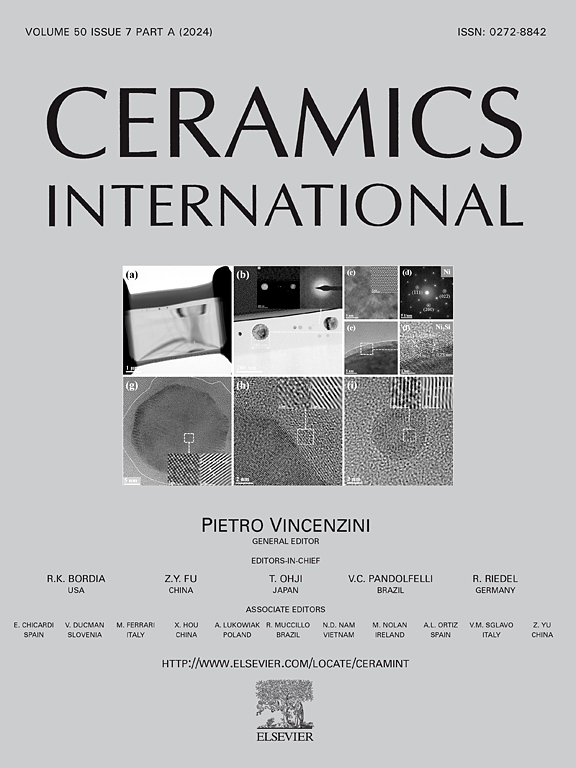Synergistic enhancement effect on surface Au nanoparticles decoration on Co-doped SnO2 nanobelts: High-response and selection for VOC gas sensing
IF 5.1
2区 材料科学
Q1 MATERIALS SCIENCE, CERAMICS
引用次数: 0
Abstract
The surface of Au nanoparticles (NPs) modified materials can greatly improve the physical and chemical properties of materials. Herein, enabling excellent sensing performances via the decoration of Au NPs on 0.5 wt% Co-doped SnO2 nanobelts (NBs) sensors is demonstrated. After decorating the content of Au NPs into three different ratios by controlling different sputtering times, denoted by Au-Co-SnO2-1, Au-Co-SnO2-1.5, and Au-Co-SnO2-2, respectively. According to the characterization results, the Au-Co-SnO2-1.5 based sensor exhibits the best gas sensing performances, for example, it achieves the highest response, which is nearly twenty times from 41 to 793, while the optimal operating temperature is reduced from 340 °C to 280 °C, and the response and recovery times have been reduced from 66 s to 63 s–44 s and 31 s in comparison with the pure SnO2 based sensor for 50 ppm 1-butanol. The morphological and microstructural properties of these NBs were analyzed through X-ray diffraction (XRD), Raman spectroscopy, Scanning electron microscopy (SEM), Brunauer–Emmet–Teller (BET) nitrogen adsorption–desorption isotherms measurement and X-ray Photoelectron Spectroscopy (XPS). The XPS results show that the corresponding response magnitude is positively correlated with the proportion of adsorbed oxygen. On the basis of the investigation, the mechanism for enhanced gas sensing performances of Au-Co-SnO2-1.5 based sensor can be primarily ascribed to the synergistic effect of increasing surface-active sites caused by oxygen vacancies, promoting the formation of additional adsorbed oxygen.
求助全文
约1分钟内获得全文
求助全文
来源期刊

Ceramics International
工程技术-材料科学:硅酸盐
CiteScore
9.40
自引率
15.40%
发文量
4558
审稿时长
25 days
期刊介绍:
Ceramics International covers the science of advanced ceramic materials. The journal encourages contributions that demonstrate how an understanding of the basic chemical and physical phenomena may direct materials design and stimulate ideas for new or improved processing techniques, in order to obtain materials with desired structural features and properties.
Ceramics International covers oxide and non-oxide ceramics, functional glasses, glass ceramics, amorphous inorganic non-metallic materials (and their combinations with metal and organic materials), in the form of particulates, dense or porous bodies, thin/thick films and laminated, graded and composite structures. Process related topics such as ceramic-ceramic joints or joining ceramics with dissimilar materials, as well as surface finishing and conditioning are also covered. Besides traditional processing techniques, manufacturing routes of interest include innovative procedures benefiting from externally applied stresses, electromagnetic fields and energetic beams, as well as top-down and self-assembly nanotechnology approaches. In addition, the journal welcomes submissions on bio-inspired and bio-enabled materials designs, experimentally validated multi scale modelling and simulation for materials design, and the use of the most advanced chemical and physical characterization techniques of structure, properties and behaviour.
Technologically relevant low-dimensional systems are a particular focus of Ceramics International. These include 0, 1 and 2-D nanomaterials (also covering CNTs, graphene and related materials, and diamond-like carbons), their nanocomposites, as well as nano-hybrids and hierarchical multifunctional nanostructures that might integrate molecular, biological and electronic components.
 求助内容:
求助内容: 应助结果提醒方式:
应助结果提醒方式:


